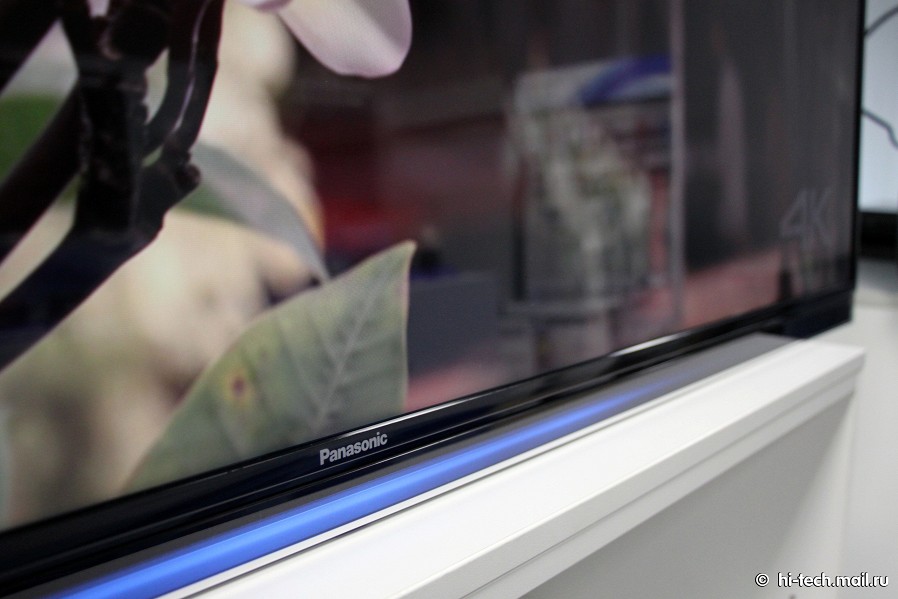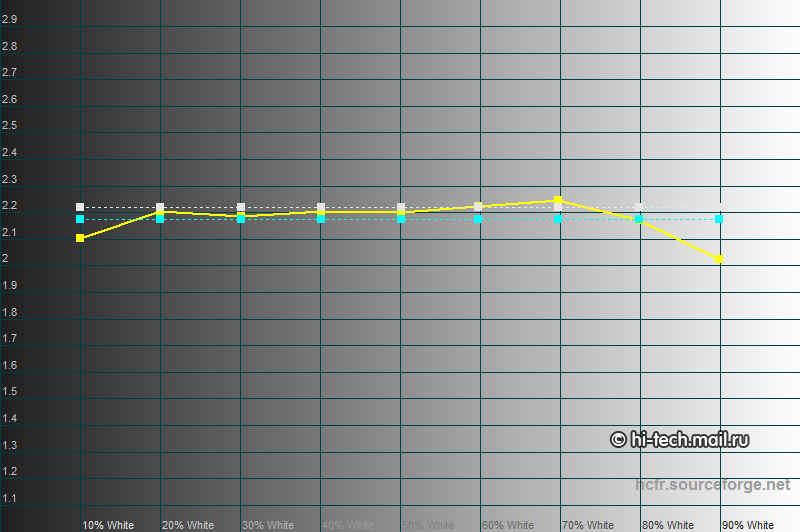Key Features
- Screen size 65 inches
- LCD matrix IPS
- Native Resolution: 3840×2160 pixels (Ultra HD)
- Processor Quad-Core Pro5
- Function 1080p / 4K Pure Direct (uncompressed signal support 1080p / 4K sampled at 4: 4: 4)
- Wide color gamut Studio Master Color
- Study gradations Studio Master Drive
- The system frame interpolation Intelligent Frame Creation (IFC)
- Certification image THX 4K Display
- Built-in speaker system: VR-Audio Master Surround 2.1
- Speaker power: 4 + 4 + 10 W (18 W)
- Digital Tuners DVB-T / T2, DVB-S2, DVB-C
- Dual tuner – “Picture in Picture” simultaneous recording and viewing
- Record essential programs on a USB-drives
- Support for DLNA (client + server)
- Interactive Platform Life + Screen c service personalization and recommendations
- Voice control
- Optional remote with touchpad
On the test model was Panasonic TX-65AXR900 diagonal of 65 inches (164 cm). The average price – 380 000 rubles.
Design and construction

Appearance Panasonic AXR900 repelled by the same ideas that formed the basis for the design of the last line. TV cabinet – the embodiment of minimalism: the screen is framed by thin frame and stand totally absent. But this is only at first glance. In fact, the body is supported by the back of a massive “legs” stand at the same time serving as a counterweight to it.



However, Panasonic AXR900 looks very “light” and even for a compact 65-inch TV. Chrome bezel adds extra gloss, a proprietary feature top Panasonic TV for several years now. At the bottom of the TV has a soft blue light that highlights the company’s logo. Its brightness can be changed in the menu, or completely shut down.

It just so happened that Panasonic AXR900 amazes design refinements. This role he leaves curved TV or other experiments. The target audience of the TV should be glad, “prosumers” always appreciated the pragmatic approach and strong design.
Interfaces, management and functionality
Panasonic AXR900 lavishly equipped with interfaces to support 4K / Ultra HD: on board has 4xHDMI 2.0 connector and DisplayPort 1.2a. Analog interfaces SCART and Component Y / Pb / Pr made through outrigger adapters. There are connectors for the general and the satellite dish, as well as Ethernet, 3xUSB, 2 card slots Common Interface, headphone jack and a digital optical output.


A distinctive feature of Panasonic AXR900 – a full-featured controller HDMI 2.0 (18 Gbit / s), which supports 2160p video signal with a frequency of 50-60 Hz and sampling is 4: 4: 4, as well as an interface DisplayPort. This allows you to use your TV as a monitor 4K-without unnecessary loss of signal. At the moment, the majority of analogues can not boast full 2160p work with in 4: 4: 4 and uses a simplified sampling of 4: 2: 0 when connected to a PC with a frequency of 60 Hz.
Complete Panasonic AXR900 attached two remote controls. The first – a classic key remote, but in a solid metal design, like AXR800. Using them is very convenient, the keys have a clear and pleasant touch, but the responsiveness of the menu was lower. Now it is not always possible to instantly navigate the menu, as it was in previous models.


The second panel has a touch touchpad and built-in microphone for voice commands. However, the touch panel does not possess the responsiveness of management: as a rule, he repeats a push-button mouse, and in free cursor responsiveness is not the best. In any case, everyone will be able to choose for themselves a more convenient option.
Life + Screen




Getting to know your personalized interface Life + Screen we cited in the review Panasonic AXR800. Fundamental differences in the model AXR900 bit: here faster processor, whereby the television higher potential for interactive services or streaming.



At the moment, it is expressed in a slightly faster system performance, although this may be due to overall optimization since the last test. The difference in the filling is not too affects the applications, if we talk about the range of Russian versions of the TV.
Image
As usual, we focus on the main TV functions – creating impressive images that would meet all quality standards. To objectively evaluate the image, we use the best tests and video benchmarks, as well as pay attention to calibrate TVs that allows you to compare them in fair conditions at the optimum settings.
Factory settings
Panasonic TV AXR900 offers a choice of a whole galaxy of picture modes: “Dynamic”, “Standard”, “Cinema», «True Cinema», «Monitor», «THX Cinema», «THX Bright Room», «Custom” and two “professional” mode with a certificate ISFccc, intended for professional calibration. An impressive list, and because each version of an endless number of additional options.
The most preferred color by default be achieved with THX Cinema. Here set the optimum brightness for a moderately lit room, which will not be beat on the eyes at home.

The average gamma – 2.17, which is very close to the reference range. Brightness optimally distributed in the image, no blockages in the shadows or light areas.

The average color temperature – about 6500K, the picture hue is also close to the reference value.

On the Panasonic AXR800 factory settings, we noted a bluish tinge, which further grew up in the shadows. In the case of Panasonic AXR900 everything is different: the TV right “out of the box” offers a neutral and clean impurities from the image, including the deep shadows. The average error Delta E on a scale of gray – 0.77 units. This is not a typo: almost everywhere observe the strictest criterion Delta E & lt; 1.

The color gamut continues to amaze. Naturally, everything is enchanted by the standard Rec. 709, upon which all video format HD and early Ultra HD. Well, that Panasonic understands how important it is to have the correct TV palette of original colors, and do not rush into extra experiments.

The high color accuracy is maintained at all intervals saturation. Distortion is very, very low.

Evaluation using ColorChecker confirms color accuracy: average Delta E – 1,11.
Looking at the almost standard graphics Panasonic AXR900, becomes no surprise that this TV is easily passed the certification of the image THX 4K Display. At the moment he is the best rendition of all tested 4K-TV – to the factory defaults will not carp.
Calibration
For the most advanced users of Panasonic AXR800 offers extensive calibration ISFccc. With these settings, the TV color reproduction can easily adjust to the required standard.

As a starting point we have chosen to adjust the brightness of 120 cd / m 2 and the target range of 2.4. Such an indicator is selected ulterior motive: gamma 2.4 is better suited for watching movies in a darkened room. Achieve a level range with a 10-point adjustment was not difficult.

The next step – setting the white balance. Here again there is a Panasonic Detailed settings “rough” 2-point adjustment and a detailed 10-point. They can be perfectly balanced image Panasonic AXR900.

The resulting color balance without any discounts can be called the reference. All gray scale corresponds to the criterion “Delta E & lt; 1″ with a decent margin. The previous record of accuracy set by Panasonic AXR800, turned out to be beaten! Average Delta E on gray scale calibrated in AXR900 – 0,17.

Setting the white balance corrected already very accurate colors. It took only a small correction to achieve the standard color at all intervals.

The average error is Delta E of 24 templates ColorChecker – 0,63. Vanishingly small error, all natural shades are transmitted reliably as possible.
Arsenal settings Panasonic AXR900 calibration has few peers among consumer televisions. What is more important – they work really effectively, so working with AXR900 – a pleasure. It is perfectly calibrated for different conditions: you can achieve high-quality images both day and night.
Contrast
The ability to display on the screen bright and dark objects with a wide dynamic range – a very important feature for any display. Senior series of Panasonic TVs have always been among the leaders in contrast, but it came plasma TVs. With the transition to the LCD panel repeatedly complicated task, and to repeat the former level at AXR900 applies advanced system of local dynamic LED-backlight.

All 65-inch TV panel highlighted an array of LEDs, broken into small areas. TV controls them according to the current image: bright areas maintain high brightness and dark areas “blacked out”, increasing the visual contrast. In this television signal processing so as to keep high the shadow detail and smooth gradation in the image. I must say that the system really works very effectively: to frank “clipping” can not even at maximum output dynamic backlight. The image on the Panasonic AXR900 remains smooth and detailed even when overt provocations on complex content.

I must say, the dynamic light works quite nicely: to notice her “intervention”, lot of hard work. In most cases, it does not distract from the view. TV very cleverly smoothes transitions between zones of illumination: If the screen has a very bright and very dark area illumination gradient builds up between them to avoid the halo effect and other artifacts. Hence the manifest and weaknesses of the system: if Avoid extreme differences, it is quite difficult to hide the low static contrast of the LCD panel IPS. But Panasonic AXR900 manages to build an incredibly delicate balance – most similar LCD TVs with local dynamic backlit easy to “pull down” effect when the screen is too large luminance transitions.
Go to the objective measurements. When the brightness of 120 cd / m 2 depth of black on Panasonic AXR900 was 0,014 cd / m 2 (on the black fill). If we evaluate the contrast of On / Off, it turns ratio at 8500: 1. Dynamic backlight – at the minimum level intervention. With a maximum black level fill obscured already to 0,007 cd / m 2 . That is, limiting the possibility of Panasonic AXR900 coming close to the plasma VT60 or ZT60, but in the “disadvantaged” mode with low brightness panel. And if for Panasonic AXR900 this limit capabilities, VT / ZT60 can do better – if the parameter “Brightness Panel” is set to “average” value.
The measurement as described in the ANSI “chessboard” size 4×4 gives already more mundane results that are closer to the static contrast LCD panel IPS. The depth of black color varies from 0.105 cd / m 2 to 0.085 cd / m 2 , depending on the mode of dynamic lighting. The real ANSI-contrast is at 940: 1. That is, the difference between static and dynamic mode – almost an order of magnitude.

Одноклассниках”>Класс
Share 































